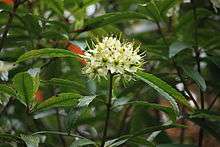Strasburgeriaceae
Strasburgeriaceae is a small family of flowering plants in the order Crossosomatales, endemic to New Zealand and New Caledonia. It contains two genera, Strasburgeria and Ixerba. Both genera have simple, evergreen, alternated leaves, often in worl-like clusters, with gland-tipped serrations, hermaphroditic, pentamerous flowers with persistent sepals, clawed petals, flat and long filaments that extend beyond the petals and a persistent style with a punctiform stigma.[1]
| Strasburgeriaceae | |
|---|---|
 | |
| Ixerba brexioides | |
| Scientific classification | |
| Kingdom: | Plantae |
| Clade: | Tracheophytes |
| Clade: | Angiosperms |
| Clade: | Eudicots |
| Clade: | Rosids |
| Order: | Crossosomatales |
| Family: | Strasburgeriaceae Tiegh. in Soler. |
| Genera | |
| Synonyms | |
|
Ixerbaceae | |
Fossil pollen named Bluffopollis scabratus, found in deposits from the Paleocene to the Miocene, is almost identical to the pollen of Strasburgeria, although only half its size. The fact that it was found in western and southern Australia and in New Zealand suggests that the most recent common ancestor of Strasburgeria and Ixerba had developed by the time of the break-up of East-Gondwana.[2]
Recent phylogenetic analysis resulted in the inclusion of the genus Ixerba (previously assigned to the monotypic family Ixerbaceae) in the Strasburgeriaceae. The following tree represents the most recent insights in the relationship between the Strasburgeriaceae and other families.[3]
| Crossosomatales |
| ||||||||||||||||||||||||||||||||||||||||||
While both Ixerba brexioides and Strasburgeria robusta share a base chromosome number of x = 25, I. brexioides is diploid (2n = 2x = 50), while S. robusta is icosaploid (2n = 20x = 500). The massive polyploidy in S. robusta may have furthered the adaptations that let it survive on the ultramafic substrates found in the montane forest of New Caledonia.[4]
Species
- Ixerba brexioides
- Strasburgeria robusta
References
- Cameron, Kenneth M. (2002). "On the Phylogenetic Position of the New Caledonian Endemic Families Paracryphiaceae, Oncothecaceae, and Strasburgeriaceae: A Comparison of Molecules and Morphology". Botanical Review. Structural Botany in Systematics: A Symposium in Memory of William C. Dickison (Oct. - Dec., 2002). 68 (4): 428–443. doi:10.1663/0006-8101(2002)068[0428:otppot]2.0.co;2. JSTOR 4354432.
- Jarzen, D.M.; Pocknall, D.T. (1993). "Tertiary Bluffopollis scabratus (Couper) Pocknall & Mildenhall, 1984 and modern Strasburgeria pollen: a botanical comparison". New Zealand Journal of Botany. 31 (2): 185–192. doi:10.1080/0028825x.1993.10419493.
- Oh, S.H. (2010). "Phylogeny and systematics of Crossosomatales as inferred from chloroplast atpB, matK, and rbcL sequences". Korean Journal of Plant Taxonomy. 40 (4): 208–217.
- Oginuma, K.; Munzinger, J.; Tobe, H. (2006). "Exceedingly high chromosome number in Strasburgeriaceae, a monotypic family endemic to New Caledonia". Plant Systematics and Evolution. 262 (1–2): 97–101. doi:10.1007/s00606-006-0451-8.